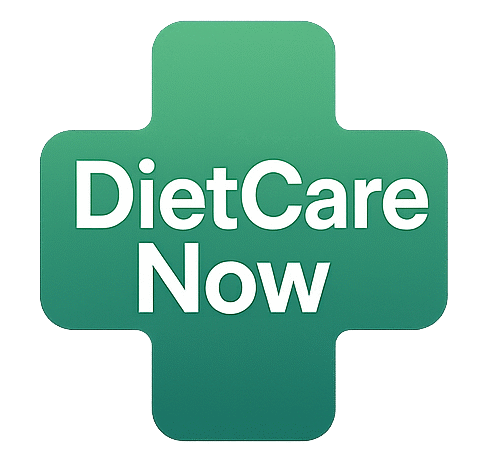Cottage cheese has long held a place in health-conscious kitchens. It’s soft, mild, and versatile—topped with fruit, folded into omelets, or spread on toast. Over recent years, demand has grown for versions with less fat and less salt, driven by concerns over heart health, hypertension, and weight control. But reducing fat and sodium while keeping flavor and texture isn’t trivial. In this article, we’ll unpack the benefits, the science, how to pick or make good options, and how to enjoy Low-Fat Low-Sodium Cottage Cheese
What Makes Cottage Cheese a Healthy Choice
At its core, cottage cheese offers several nutritional strengths:
- High protein: Cottage cheese supplies casein and whey proteins, which digest slowly and help with fullness and muscle maintenance.
- Calcium and other minerals: As a dairy product, it contributes calcium, phosphorus, and sometimes magnesium and potassium.
- Potential probiotics: Some cottage cheeses are made with live cultures, though not all.
However, not all cottage cheese is created equal. Regular (full-fat) versions often carry more saturated fat and sodium. In contrast, low-fat and reduced sodium versions aim to preserve the protein and mineral benefits while lowering what many people try to limit: fat and salt.
Choosing a reduced-sodium option can particularly benefit those concerned with blood pressure and cardiovascular health. High sodium in many cheeses is a well-known caveat in nutrition reviews.
Also read: /cooked-chicken-thighs-nutrition/
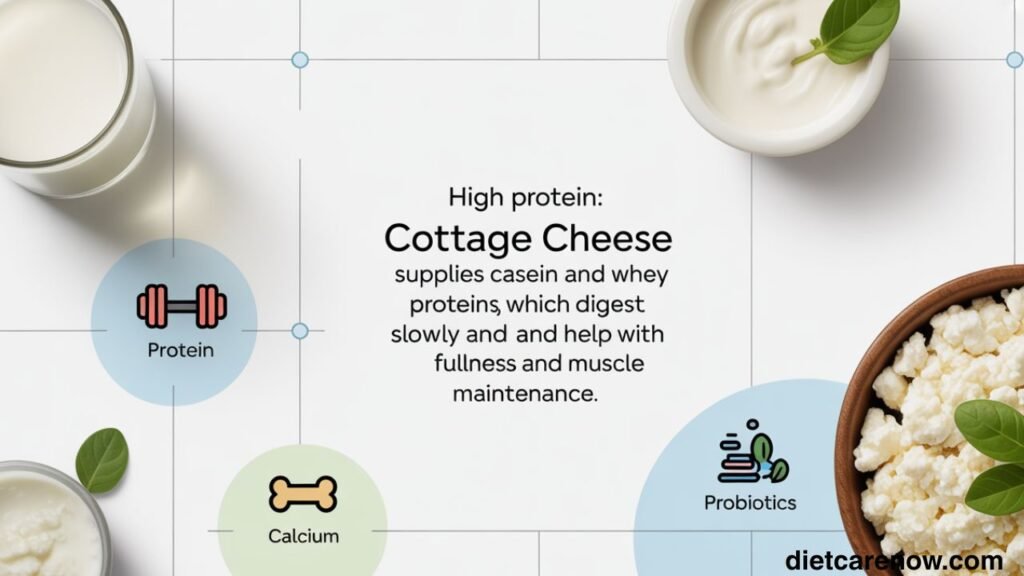
Understanding Fat and Sodium in Dairy Products
Why fat and sodium matter
- Excessive saturated fat is linked (though not conclusively in all studies) to increased LDL cholesterol and cardiovascular risk.
- High sodium intake is more directly implicated in hypertension, cardiovascular disease, and kidney stress. Many people’s salt consumption already approaches or exceeds recommended limits.
When dairy products are processed, salt is often added not just for flavor but for preservation and to control moisture. In cottage cheese, which has high moisture, sodium helps maintain structure and shelf stability.
How manufacturers manage reductions
Reducing fat or sodium while keeping a pleasing texture and taste is a balancing act. To lower fat, producers may use skim or partially skimmed milk, and add small percentages of cream or cultured dairy to improve mouthfeel. To reduce sodium, they may:
- Use milder curd washing and draining to remove saltier whey
- Use buffering agents or mineral salts (e.g. potassium chloride) in small amounts
- Add flavor enhancers or herbs to compensate for the flavor loss
These methods must be implemented carefully to avoid creating a dry or bland product.
How Low-Fat Low-Sodium Cottage Cheese Is Made
Here’s a simplified outline of how you might produce or modify cottage cheese to be low in fat and sodium:
- Milk selection: Start with low-fat or skim milk (0–2 % fat) as the base.
- Pasteurization: Heat-treat the milk for safety.
- Acidification / Culture addition: Add starter cultures or direct acid (e.g. lactic cultures, rennet, or mild acid) to curdle the milk.
- Curd formation: After curdling, the curds separate from whey.
- Cutting and heating curds: Cut curds, often heat them mildly to expel some whey.
- Washing or rinsing: A key step when reducing sodium: wash the curds in cool water to remove residual whey (which carries dissolved salts).
- Draining and draining control: Let the curds settle and expel moisture; adjust texture by controlling the drain time.
- Dressing / cream addition: A small amount of light cream or cultured milk may be blended in to soften texture.
- Salt / mineral additions: Add a minimal amount of salt or substitute (e.g. potassium salts) for flavor.
- Cooling and packaging: Rapid cooling and packaging under hygienic conditions.
With proper washing and curd handling, sodium levels can be reduced significantly without making the cheese inedible or overly bland.
Nutritional Profile: Comparing Regular vs. Low-Fat Low-Sodium Cottage Cheese
Here’s a comparison (approximate) to show how much difference the “low-fat, low-sodium” versions can make:
| Metric | Regular Cottage Cheese (2 % fat, standard sodium) | Low-Fat, Low-Sodium Cottage Cheese |
|---|---|---|
| Serving size | ½ cup (113 g) | ½ cup (113 g) |
| Calories | ~ 85–100 kcal | ~ 80–90 kcal (slightly lower) |
| Protein | ~ 11–14 g | ~ 12–14 g (protein largely preserved) |
| Total fat | ~ 2–4 g (with some saturated) | ~ 0.5–1 g or up to 2 % (depending on formulation) |
| Sodium | ~ 200–400+ mg or more | As low as ~ 45–70 mg (or up to 150–200 mg) |
What to look for on labels:
- Fat percentage (look for “low-fat,” “1%,” or “nonfat”)
- Sodium in mg per serving
- Ingredients: minimal additives, no “mystery salts”
- Presence of “no added salt” or “reduced sodium” claims
Because sodium varies widely between brands, two “low-fat” cottage cheeses might differ significantly in salt content.
Health Benefits of Low-Fat Low-Sodium Cottage Cheese
Supports heart health & blood pressure
Reducing sodium intake helps lessen the risk of hypertension and related cardiovascular disease. Choosing a low-sodium cottage cheese means you can still enjoy dairy protein without overshooting your salt budget.
Aids weight management
High-protein foods increase satiety, reducing the temptation to snack. Cottage cheese’s slow-digesting proteins help with fullness, and replacing higher fat dairy or creamy sauces with a low-fat version can cut calories.
Promotes muscle repair & bone strength
The protein helps with muscle maintenance and recovery, especially in active individuals. The calcium, phosphorus, and other minerals support bone health and mineral balance.
Suitable for specific diet needs
Because sodium and fat are restricted, this kind of cottage cheese fits better into low-sodium, low-cholesterol, renal, or cardiac diet plans—provided potassium or phosphorus are not contraindicated for specific patients.
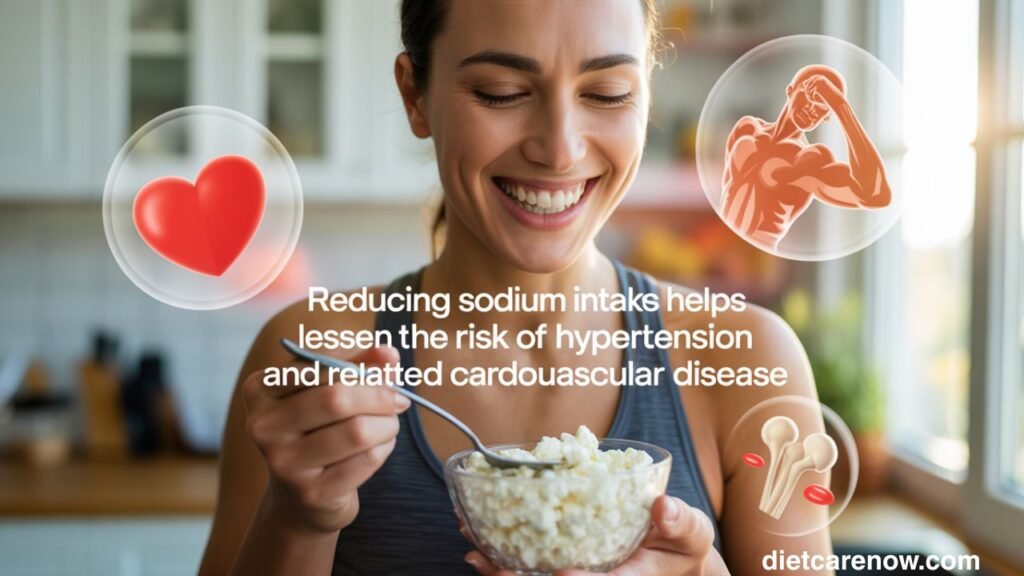
Who Should Eat Low-Fat Low-Sodium Cottage Cheese
- People with hypertension or heart disease who must restrict sodium intake
- Individuals with kidney disease, where both sodium and fat control is often crucial (but consult a renal dietitian for potassium/phosphorus)
- Athletes or fitness-oriented people wanting lean protein with minimal added fat or salt
- Weight-watchers who want satisfying dairy without extra calories
- Seniors who need calcium and protein but want to avoid excess saturated fat or salt
That said, unless medically restricted, many healthy adults can include moderate amounts of standard cottage cheese—just choosing the lower-sodium versions helps.
How to Include It in Your Daily Diet
Here are practical, easy ways to incorporate low-fat, low-sodium cottage cheese:
Breakfast
- Spread on whole-grain toast with sliced tomatoes, pepper, and herbs
- Mix into oatmeal or porridge for extra protein
- Blend with berries and a splash of milk for a high-protein smoothie
Snacks
- Pair with raw veggies (cucumber, carrot sticks) as a creamy dip
- Top fresh fruit with a scoop of cottage cheese and cinnamon
- Use as a filling between rice cakes or whole-grain crackers
Lunch / Dinner
- Use it in place of cream cheese in sandwich spreads
- Fold into scrambled eggs
- Mix with cooked pasta, herbs, and veggies as a light pasta salad
- Replace ricotta in lasagna, stuffed peppers, or baked dishes
Portioning and pairing tips
- Stick with about ½ cup (113 g) as a serving
- Combine with fiber-rich foods (vegetables, whole grains, fruits) to balance the meal
- Add fresh herbs, pepper, citrus juice, or garlic instead of extra salt
Delicious Recipes Using Low-Fat Low-Sodium Cottage Cheese
Here are some simple recipes to try:
Cottage Cheese Smoothie Bowl
Ingredients:
- ½ cup low-sodium cottage cheese
- ½ cup unsweetened almond milk (or low-fat milk)
- ½ banana
- ½ cup frozen berries
- Toppings: chia seeds, sliced fruit, nuts
Method:
Blend cottage cheese, milk, banana, and berries until smooth. Pour into a bowl and top as desired.
Low-Sodium Veggie Dip
Ingredients:
- 1 cup low-sodium cottage cheese
- ½ cup plain low-fat yogurt
- 1 clove garlic, minced
- 1 tsp lemon juice
- Fresh herbs (parsley, dill, chives)
- Black pepper
Method:
Blend all ingredients until smooth. Chill 30 minutes. Serve with cut veggies or whole-grain chips.
Protein Pancakes or Wraps
Ingredients:
- ½ cup low-sodium cottage cheese
- 1 egg + 2 egg whites
- ¼ cup oats or oat flour
- Pinch of cinnamon or vanilla
Method:
Blend all ingredients. Pour onto nonstick skillet to make pancakes or cook thin to use as wraps. Serve with fruit or savory fillings.
Cottage Cheese Parfait (Dessert)
Ingredients:
- ½ cup cottage cheese
- ¼ cup plain Greek yogurt
- Fresh berries
- Drizzle of honey or chopped dates
- Optional: nuts or granola (low-salt)
Method:
Layer yogurt, cottage cheese, berries, and toppings in a glass.
Tips for Choosing the Best Brand
- Check sodium per serving — aim for the lowest reasonable number
- Look for “no added salt” or “low sodium” claims
- Check fat percentage and choose 1% or nonfat as appropriate
- Look at ingredient list — fewer additives is better
- Prefer live and active cultures (if you want probiotics)
- Read serving size carefully — some packages may list unrealistically small servings
Brands like Hood offer a No Salt Added Low Fat Cottage Cheese with ~ 60 mg sodium per ½ cup. Other brands like Breakstone’s “45% less sodium” or Friendship “no salt added” are also options. Always compare labels.
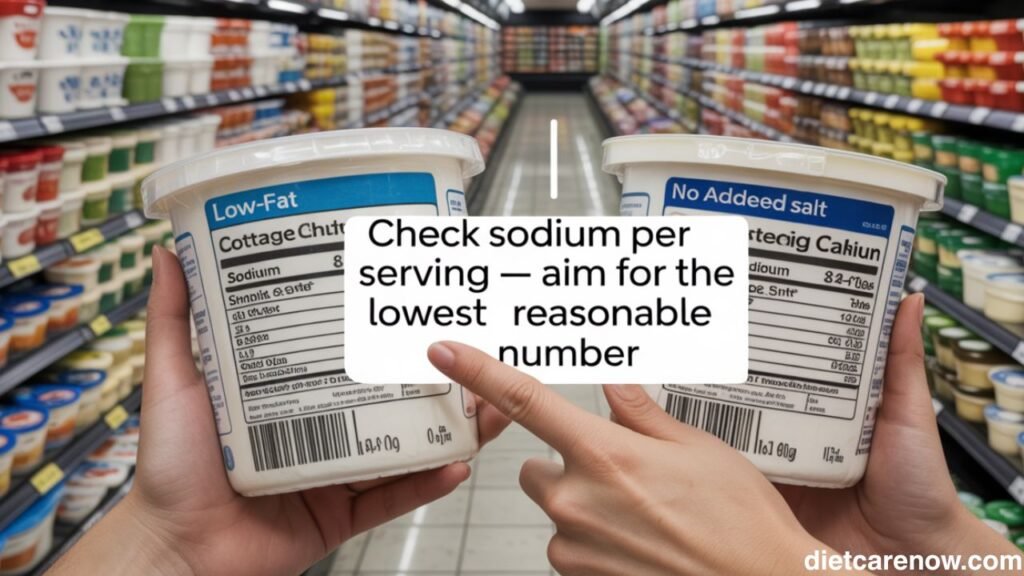
DIY: How to Make Low-Fat Low-Sodium Cottage Cheese at Home
Making your own gives you full control over fat and sodium. Here’s a basic version:
Ingredients:
- 1 gallon (about 3.8 L) skim or low-fat milk
- ¾ cup white vinegar (or lemon juice)
- ⅛ tsp salt (optional, or skip entirely)
- (Optional) ½ cup light cream for dressing/texture
Method:
- Heat the milk slowly in a large pot to about 120 °F (50 °C).
- Remove from heat and stir in the vinegar (or lemon juice). Stir gently for 1–2 minutes. Curds should begin forming.
- Cover and let sit ~30 minutes.
- Cut the curds into small cubes; then gently heat to ~130–135 °F (54–57 °C) while stirring occasionally.
- Drain the curds in cheesecloth or fine strainer; allow the whey to drip.
- Optionally rinse curds with cool water to remove residual whey (which helps reduce sodium).
- Let curds drain further.
- Gently stir in the light cream (if using) to soften texture.
- Add a pinch of salt if desired (you may skip entirely for very low sodium).
- Store in airtight container in refrigerator, ideally used within 5–7 days.
You can flavor it naturally with herbs, pepper, or fruit.
Common Myths About Cottage Cheese
Myth: All cottage cheese is high in sodium.
Truth: Some are, but “no salt added” and low-sodium varieties exist. Checking labels makes a big difference.
Myth: Low-fat versions lack flavor.
Truth: They are milder, but herbs, fruit, spices, and good pairing can restore full enjoyment.
Myth: Cottage cheese is only for bodybuilders or dieters.
Truth: It’s nutritious and convenient for many people, not just fitness fans. It can fit into everyday balanced diets.
Storing and Shelf Life Tips
- Refrigerate immediately after opening.
- Use within 5–7 days for best quality.
- Always keep container sealed to prevent contamination.
- Smell and visual check: sour or off odor or visible mold are signs it’s spoiled.
- Freezing? Not ideal: texture becomes grainy. If you must, freeze in small portions and thaw in fridge, then stir well. Using it in cooked dishes or smoothies after thawing is better than eating plain.
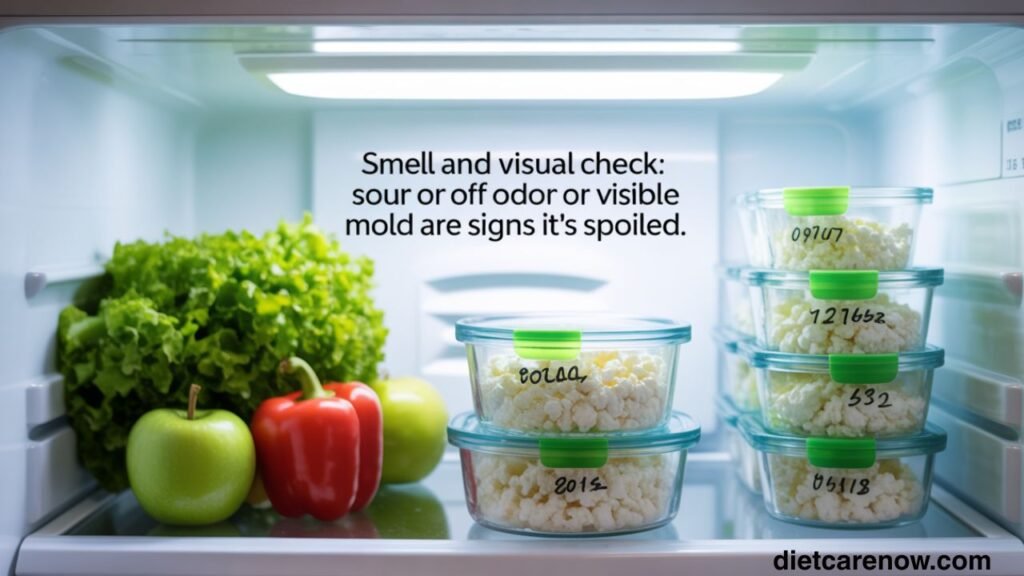
Expert Opinions and Nutritionist Insights
- Harvard public health experts warn that cottage cheese, though trendy, can hide high sodium—so moderation and smart choices matter.
- Consumer Reports notes that sodium is the “nutritional negative” for cottage cheese, urging consumers to choose low-sodium brands.
- Dietitians often list low-sodium cottage cheese among their preferred cheeses when salt control is a goal.
- In recommendations, a ½ cup serving is often suggested as reasonable for protein and dairy contributions, assuming sodium is moderate.
Conclusion: A Smart Step Toward Healthier Eating
Low-fat, low-sodium cottage cheese is more than a fad: it’s a thoughtful swap. You retain the protein, calcium, and versatility of cottage cheese, while cutting down on saturated fat and sodium—two nutrients many people overconsume. Whether you buy a smart brand or make your own, integrating it into meals can boost nutrition and reduce less desirable ingredients
